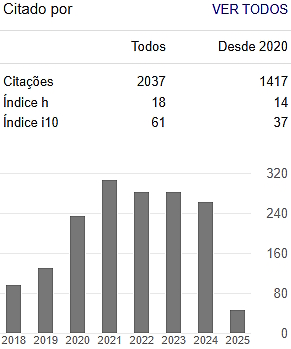MARCAÇÃO, DISPERSÃO E CAPACIDADE DE PARASITISMO DE Cotesia flavipes (CAMERON) (HYMENOPTERA: BRACONIDAE)
Palavras-chave:
controle-biológico, voo, broca da cana de açúcar, corante lipossolúvel.Resumo
O objetivo deste trabalho foi avaliar os aspectos biológicos de C. flavipese sua marcação, além do desenvolvimento de uma metodologia para captura de adultos. Lagartas de D. saccharalis alimentadas com dieta artificial contendo os corantes SudanRed 7B e Solvent Blue 35 nas concentrações de 200 e 400 ppm, óleo vegetal a 200 e 400 ppm e sem óleo. Posteriormente, as lagartas foram parasitadas nos tratamentos supracitados. Avaliou-se o período entre o parasitismo e a emergência das larvas (ovo-larval), a empupação, o peso das massas e das pupas, razão sexual, longevidade dos adultos e marcação. Após a definição do corante/concentração adequado para marcar adultos de C. flavipes, avaliou-se a capacidade de dispersão e parasitismo das fêmeas adultas em condições de campo. Utilizou-se o teste de Dunnett para as variáveis relacionadas ao desenvolvimento de larvas, pupas e adultos de C. flavipes e o procedimento de GLM para análise de variância e o LSMEANS para ajustar as medias em cada fator testado. Definiu-se o corante SudanRed 7B na concentração de 200 ppm é o melhor corante/concentração para marcar o parasitoide larval C. flavipes, após desenvolvida a metodologia para captura de C. flavipes, que associadas à marcação, permitiram avaliar a capacidade de voo pela distância e captura desses indivíduos com precisão. Foi definida a armadilha de garrafa pet 600 como a melhor para avaliação de captura e parasitismo. A distância máxima de voo de indivíduos em campo foi de 17 metros, sendo que o maior número capturado foi até cinco metros.
Downloads
Referências
BOTELHO, P. S. M; MACEDO N. Cotesia flavipes para o controle de Diatraea saccharalis, p. 477-494. In J.R.P Parra, P.S.M. Botelho, B.S. Corrêa-Ferreira & J.M.S. Bento (eds.), Controle biológico no Brasil: parasitóides e predadores. São Paulo, Manole, p. 635, 2002.
CAIXETA, D. F. Marcação, voo tutorado e dispersão de Anticarsia gemmatalis (Hübner) (Lepidoptera: Erebidae) e Chrysodeixis includens (Walker) ( Lepidoptera: Noctuidae) / Daniel Ferreira Caixeta. – Jaboticabal, 2014
CONRAD, K. F.; WILLSON, K. H.; WHITFIELD, K.; HARVEY, I. F. J.; CHRIS. THOMAS; THOMAS N. SHERRATT. "Characteristics of dispersing Ischnura elegans and Coenagrion puella (Odonata): age, sex, size, morph and ectoparasitism."Ecography, v. 25, n. 4, p. 439-445, 2002.
FERNANDES, O. A. 2002. O uso de marcadores no controle biológico, p. 115-121. In J.R.P PARRA, P.S.M. BOTELHO, B.S. Corrêa-Ferreira & J.M.S. Bento (eds.), Controle biológico no Brasil: parasitóides e predadores. São Paulo, Manole, 635p.
HOLLOWAY, T. E.; HALEY, W. E.; HEINRICH, C.; LOFTIN, U. C. The sugar-cane moth borer in the United States.US Government Printing Office.80 p. (Technical Bulletin, 41), 1928.
KING, E. G; HARTLEY, G. G. Diatraea saccharalis. In: SINGH, P.; MOORE, R. F. (Eds.). Handbook of insect rearing. New York: Elsevier, p. 265-270, 1985.
LONG, W. H.; HENSLEY, S. D. Insect pests of sugar cane. Annual review of entomology, v. 17, n. 1, p. 149-176, 1972.
MACEDO, N.; BOTELHO, P. S. M. Controle integrado da broca da cana-de-açúcar, Diatraea saccharalis (Fabr., 1794)(Lepidoptera: Pyralidae). Brasil Açucareiro, v. 106, n. 2, p. 2-14, 1988.
OSTLIE, K. R.., HEIN, G. L., HIGLEY, L. G., KASTER, L. V., & SHOWERS, W. B.. "European corn borer (Lepidoptera: Pyralidae) development, larval survival, and adult vigor on meridic diets containing marker dyes." Journal of economic entomology, v. 77, n.1, p. 118-120, 1984.
ROSSATO, J. J. A. de S. Diatraea saccharalis(Fabr.)(Lepdoptera:Crambidae) e Mahanarva fimbriolata (Stal)(Hemiptera:Cercopidae) em cana-de açúcar: impacto na qualidade da matéria-prima, açúcar e etanol. / José Antonio de Souza Rossato Junior. –Jaboticabal, 2012.
SOUTHWOOD, T. R. E. 1992. ecological methods: with particular reference to the study of insect populations, london: Chapman & Hall, 524 pp.
VILARINHO, E. C.; FERNANDES, O A; OMOTO, C; HUNT, T. E. Oil-Soluble Dyes for Marking Spodoptera frugiperda (Lepidoptera: Noctuidae). Journal of Economic Entomology, Lanhan, v.99, p.2110-2115, 2006.
VOLPE, H. X. L., A. M. VACARI, A. C. P. VEIGA, S. R. VIEL, S. A. DE BORTOLI. "Effect of Sudan Red B Dye in the mark and development of Diatraea saccharalis (Fabricius, 1794)(Lepidoptera: Crambidae) and Cotesia flavipes (Cameron, 1891)(Hymenoptera: Braconidae)." Boletín de Sanidad Vegetal, Plagas, v. 35, n. 2, p. 239-247, 2009.
VOLPE, H. X. L. Distribuição espacial do parasitismo de Cotesia flavipes (Cameron, 1891) (Hymenoptera: Braconidae) em cana-de-açucar. 2009 xii 67 f. dissertação (mestrado) – Universidade Estadual Paulista, Faculdade de Ciências Agrarias e Veterinárias, 2009.
VOLPE, H. X. L. Distribuição espacial do parasitismo de Cotesia flavipes(Cameron, 1891) (
WALDBAUER, G. P. The consumption and utilization of food by insects. Advances in insect physiology, v. 5, p. 229-288, 1968.
WHITE, W. H., REAGAN, T. E., SMITH, J. W., & SALAZAR, J. A. Refuge releases of Cotesia flavipes (Hymenoptera: Braconidae) into the Louisiana sugarcane ecosystem. Environmental entomology, v. 33, n. 3, p. 627-632. 2004.
WIEDENMANN, Robert N.; SMITH JR, J. W. Use of ablated stalks to assess field rates of parasitism of Diatraea saccharalis (Lepidoptera: Crambidae) by Cotesia flavipes (Hymenoptera: Braconidae). Biocontrol Science and Technology, v. 16, n. 1, p. 37-48, 2006.
Downloads
Publicado
Edição
Seção
Licença
Copyright (c) 2020 Colloquium Agrariae. ISSN: 1809-8215

Este trabalho está licenciado sob uma licença Creative Commons Attribution-NonCommercial-NoDerivatives 4.0 International License.

